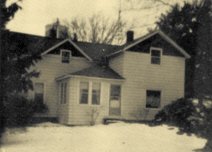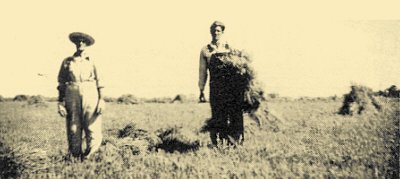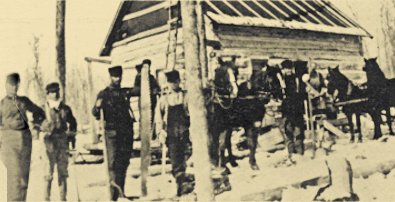
BEGINNINGS OF THE TOWN OF YORK, WISCONSIN
Recorded in the "York Methodist Church Centennial 1880 - 1890"
The history of the Township begins in the late 1840's when the land in Clark Co. was surveyed into townships. The establishment of the Principal Meridian between what is now York and Fremont was the first surveying done in the county and was done in 1846. In 1847, the Town of York (Town 25) Loyal (26), Weston, Eaton and Warner was divided and surveyed. Section lines were run much later.
A crew of surveyors and helpers with ox teams cut a path through the trees and brush and established township markers. The surveying into sections was done later about the 1870's into the 1880's. After John Kintzele arrived in 1883, he surveyed much of York and Fremont and the Village of Granton. This was into section and quarter sections and the streets in Granton.
Most of the northern part of York was the property of the Fox and Wisconsin Rivers Improvement Co. given in 1853 and filed in Clark Co. in 1857. These lands were mortgaged to build the canal of Portage for $500,000 to Isaac Seymour and William J. Averill, financiers of New York City. On the death of the partners, Abraham Clark was the sole surviving heir. The area involved was 21 sections and parts of 10 others. Foreclosures on the land took place in 1864, but were not recorded until 1918. These were filed in several counties, Outegamie, Fond du Lac and Clark --- over 5000 acres in this area. The land titles were finally cleared by an act of the State Legislature in 1918.
Part of this area was sold to the Green Bay and Mississippi Canal Co. in 1866. The pine timber on it was sold to be removed by 1879. In 1891, much of the land was sold to the Davis and Starr Lumber Co. Before this Romadka Mfg. Co. in 1883 and later purchased some of it as well as other loggers and smaller operators.

York, York Township, Wisconsin
The name for the newly organized township 25 was to become "York", probably because so many of the early settlers were natives of New York State. These included the Davises, Downers, Lees, Holmes and others.
The first resident of the Town of York was Charles Renne, who came here in 1857, probably as part of a surveying crew. Two years later his brother Hiram also came and they built log buildings and cleared land in the summer and worked in the woods in the winter. The Windfall Corners area in the S. E. corner of Sec. 35, was the site of the first settlement. Charles had an early sawmill in the area and sawed the lumber for the first frame house in the town. It is thought to be the Marvin Naedler house. Hiram Renne is also known to have had a house nearer the corner to the south probably built at about the same time. He married Eveline Marsh, a daughter of Levi Marsh in 1861.

The Rennes built this house - probably the first frame house in the town. The Renne's parents came after the house was built for them and lived the rest of their lives in the area. In 1865, the place was sold to Harmon Allen, who with his family, lived there until his wife's death in 1886. He then sold the land. The reason for the early settlement in this area was it was on the trail to Stevens Point, which followed the township line to the east.
The other very early settlement was in the County
Farm area where the Northrups came in 1861. Famings must also have been in the area soon after that, as Mrs. Ann Farning was widowed when her husband went to the Civil War and never returned. The original 80 acres of the "Poor Farm" is so recorded in the first assessment roll of 1873 of the Town of York.
The area that came to be known as "York Center" seems to have been established about 1870, though I have no exact information earlier than 1873 when a few families had arrived. The other area with a few settlers was on what is now the, corner of H and the town line. Here were the Martin Heaths, Chas. Rollins, John Wright, Charles & Ira Robbins, and John Duffy.
The reason for the early settlement around "Windfall Corners" was that the trail came from the south at Mapleworks then turned east at this point. "Windfall Corners" got its name from the fact that a high wind had blown all the trees down in the area at some time before settlement, and they lay there for some years. The only reminder now is that the cemetery, located just to the south of the corner, is still called "Windfall Cemetery". Many of the early settlers of the East Side of the town are buried there.

Early York Farmer Shocking Oats
The early roads were along the township line on the south side of York where what was known as the "Middle Road" to Neillsville was an important link to the County Farm area. In fact, it seems to be the reason that the first row of 1/2 sections of what is now the Town of Grant was included in the Town of York in 1873. Later that year they were given back to Grant. Romadka Road, as it came to be known, did not extend through to what is now H until after 1900. It turned east past what is now Rueben Anderegg's house and went thence up over the hill diagonally over to the town line area. The reason seems to have been that the trees up the hill past the Canfield and Johnson places were so large that there was difficulty in removing them to make a road.

1900's logging camp - (note the cook). Taken by John Kintzele on glass plate.
The northern part of the town was settled later. The Green Bay Co. had held the land. There must have been some sale of it in 1870, but the state disallowed its sale and it was reassessed by order of the State and Clark County in this statement recorded in the 1878 assessment rolls. "The Board of Supervisors of the County of Clark, do order and determine the follows: 'That the list of lands hereunto attached, upon which the Supreme Court of the State of Wis. has declared the tax of 1870 sale 1871 to be null and, void, shall be re-assessed for the year 1870 in the year 1878, under Chap. 324 General Laws of 1878 by the Town assessor of the town in which said lands are located being Town 25--l W and known as the Town of York. Dated April 26, 1878. " William Welch, Chairman of the County Board of Supervisors.
By 1884, several lumbermen and lumber companies had bought the land in the area. They included Samuel Marsh, the Romadka Mfg. Co., John Magee, Martin Seitz, E. Corning and several small holders, including George Meyer, George Spangler, W. W. Beach and Chester Cook. Heintown was established soon after this by John Hein and his son Tony.
|
© Every submission is protected by the Digital Millennium Copyright Act of 1998.
Show your appreciation of this freely provided information by not copying it to any other site without our permission.
Become a Clark County History Buff
|
|
A site created and
maintained by the Clark County History Buffs
Webmasters: Leon Konieczny, Tanya Paschke, Janet & Stan Schwarze, James W. Sternitzky,
|